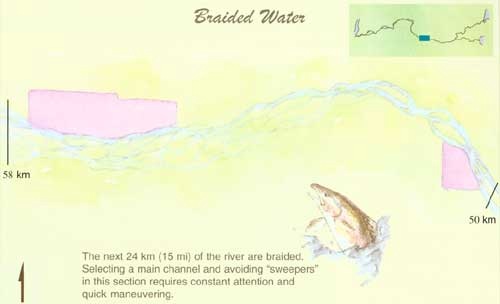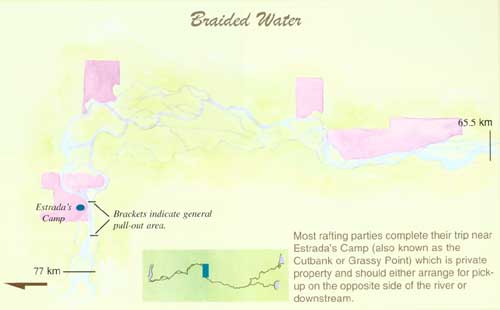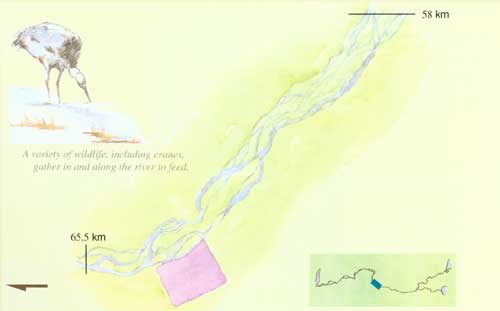|
ALAGNAK
Alagnak Wild River An Illustrated Guide to the Cultural History of the Alagnak Wild River |

|
THE 20TH CENTURY
In 1900 the North Alaska Salmon Company built two canneries near the junction of the Alagnak and Kvichak Rivers. The cannery at the river mouth became known as Lockanok and the other cannery, 1000 feet upstream on the Kvichak River, was called Hallerville, in honor of J.P. Haller, president of the company. The two canneries were connected by a narrow gauge railroad that brought salmon from Hallerville to be processed at the Lockanok plant.
The Alagnak River was not only used by Yup'ik people from the Kvichak River but also from the Nushagak and even Yukon and Kuskokwim drainages, a testament of its rich subsistence resources during the historic period. In addition, availability of commercial fishing jobs at Kvichak canneries also attracted subsistence users from as far away as the Yukon River. Cash income from the commercial salmon industry allowed Alagnak subsistence users to purchase more store-bought food, such as coffee, tea, sugar, and salt.

|
| The Libby, McNeill and Libby cannery at Lockanok was built in 1900 at the mouth of the Alagnak River by the North Alaska Salmon Company from San Francisco. The cannery reportedly burned in 1937. Photo circa 1920-1930. |
Historically there had been many villages and cabins at various locations on the Alagnak River, including near the forks of the Alagnak and Nonvianuk Rivers and another village known as "Sleepy Town" on the right side downstream from the forks. Apparently, some of the houses in these settlements were traditional semi-subterranean and some were above ground log houses. Branch River village was the last historic settlement on the river and was abandoned by the 1960s. It was located about 4.8 km (3 mi) above the Alagnak-Kvichak confluence on the north side of the river. Some of the families who lived at the village or who were dispersed along the river were: the Andrews, the Chukwoks, the Tallekpaleks, the Apokedaks, the O'Neills, the Frenchie Brooks, Lars Olson, the Guy "Sonny" Groat, Jr. family, and the George Petersons. Previously, Peterson, a crack marksman, had worked for Father Bernard Hubbard in his explorations around the Alaska Peninsula. The Branch River was the site of the Saint Innocent Russian Orthodox church, which was last visited by a priest from Newhalen in the 1950s.
Another small historic community, Lockanok, was located about one and a half miles up river from the Lockanok cannery. Lockanok village consisted of a few Euroamerican fishermen who also trapped and prospected and who built framed houses made from salvaged cannery lumber and sided with sheet iron.

|
| This photo shows Okalina Nelson, Pat Andrew, and John Nelson (from left to right) at Eau Andrew's house on the Branch River or at Levelock, circa 1940. Many frame houses on the lower Alagnak and Kvichak Rivers were constructed of salvaged lumber from abandoned canneries. |
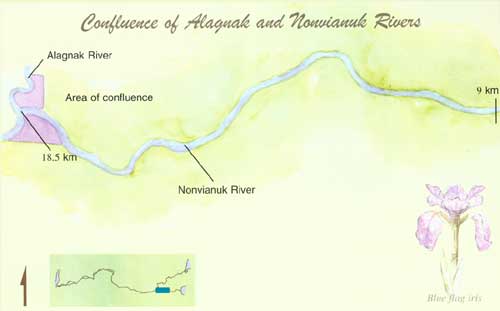
|
|
Confluence of Algnak and Nonvianuk Rivers (click on image for a PDF version) Blue flag iris. |
Information from local Native elders has revealed that the Lockanok village site contains a mass grave of Spanish flu epidemic victims. The adult population of two nearby Kvichak villages, Koggiung and Kaskanak were also decimated by the Spanish flu of 1919.
Some of the men who lived at the village were Martin Monsen, Jr., Simeon Larson, Charlie Olson, Frenchy Rosseau and his son Oscar Rosseau, Harry Langord, and Billy Gleason. The Canadian-born Rosseau frequently prospected the Valley of Ten Thousand Smokes in Katmai National Monument and the Irish-born Gleason had long been a Portage Creek, Lake Clark placer gold miner since about 1913. The Euroamericans copied their Native neighbors in dividing their time in seasonal economic pursuits: trapping in the fall and winter, cannery work in the spring, and commercial fishing in the summer.

|
| Pomela Benet Fischer or "Yukon Pom" (1920-1991) with her son, Jerry Benet, near Branch River village in 1947. Pomela was born on the lower Kuskokwim River at Old Napaimiut to a Yup'ik mother and French Canadian father. Pomela was a lifelong subsistence gatherer who was known for her excellent smoked salmon and dog teams. Photo courtesy of Joanne E. Sargent-Wolverton. |
In 1916 Libby, McNeill & Libby purchased both the Lockanok and Hallerville canneries from the North Alaska Salmon Company. Kvichak River erosion and shifting channels rendered Hallerville inoperable in the early twentieth century but the Lockanok cannery ran until 1936 when a change in the Kvichak channel made it impossible to operate economically and much of the plant burned in 1937.
Subsequently, much of the usable cannery lumber was salvaged and used for homes in the nearby Kvichak River village of Levelock. Salvage efforts were so thorough that entire buildings were moved over the ice of the frozen Kvichak River to Levelock.

|
| Lockanok cannery was built in 1900 by the North Alaska Salmon Company near the confluence of the Alagnak and Kvichak Rivers. Photo courtesy of Violet Willson. |
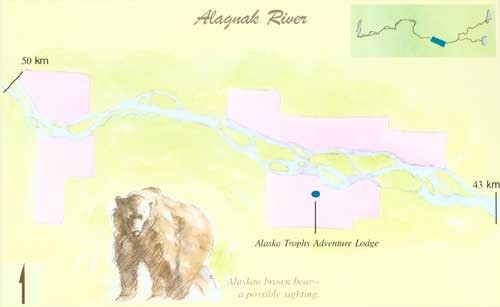
|
|
Alagnak River (click on image for a PDF version) Alaskan brown bear—a possible sighting. |
One of the most significant historical events in Bristol Bay history occurred in June 1927 when pilot Russell Merrill of Anchorage Air Transport flew a Travel Air to Lockanok cannery marking the first airplane landing in the Bristol Bay region. This was a transformative event that would effectively lead to a new era of air transport for this formerly inaccessible region.
By the 1960s and early 1970s all the Alagnak families had left Branch River village for nearby communities of Levelock, Igiugig, Kokhanok, and Naknek. The modern world with all its opportunities and pressures had intruded on isolated Branch River village. Since children were now required to attend school most families moved to Levelock where the closest school existed.

|
| A view upstream along the intertwining channels of the Alagnak River at a popular ending point for rafters. Photo courtesy of Janet Curran, United States Geological Survey (USGS). |
Presently, Natives from surrounding villages, many with deep roots on the river, use the Alagnak for subsistence hunting, fishing, and trapping activities. In addition, there are a number of lodges on the Alagnak and a great amount of sport fishing effort.
Big game guide Bud Branham stated that he had guided hunters and sport fishermen on the Alagnak as early as 1937. New York sportsman and writer, Dan Holland, writing in the April 1941 issue of Field & Stream magazine, probably made the first mention of the Alagnak River as a great trophy rainbow trout stream. Sport fishing on the Alagnak dates mostly from the post WWII era. The major guides of this era were Bud and Dennis Branham, John Walatka, Ed Seiler, Sonny Groat, Jay Hammond, and Dean Paddock of King Salmon in the 1960s. Hammond first saw the Alagnak River when he flew to Nonvianuk Lake with guide Bud Branham to visit Bill Hammersley in 1946 or 1947. Between 1940 and 1945, Rufus Knox "Bill" Hammersley and his wife Margaret constructed a cabin, cache, and root cellar near the outlet of Nonvianuk Lake. A resident of Alaska since 1926, Bill fished in Bristol Bay, worked as a manager of the nearby Northern Consolidated Airlines camp, and trapped, hunted, and guided throughout the area. In 1957 Hammond had an arrangement with John Tallekpalek to use his cabin while guiding sport fishermen on the Alagnak River. Bob Cusack established the first lodge, a restored cannery galley-scow that was towed up the Alagnak from Naknek about 1973.

|
| Small islands and gravel bars clot the Alagnak up stream from the Braids. Photo courtesy of Janet Curran, USGS. |
| <<< Previous | <<< Contents>>> | Next >>> |
alag/cultural-history/sec5.htm
Last Updated: 22-Jun-2009



